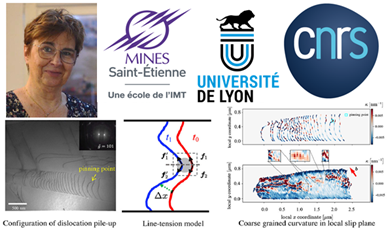NOMATEN HYBRID-SEMINAR May 30: Austenitic HEA/MPEA : from the Cantor alloy to precipitation hardened Co-free alloys with optimised mechanical resistance
NOMATEN HYBRID-SEMINAR
online: https://www.gotomeet.me/NCBJmeetings/nomaten-seminar
In-person: NOMATEN seminar room
Tuesday, MAY 30th 2023 13:00 CET
Austenitic HEA/MPEA : from the Cantor alloy to precipitation hardened Co-free alloys with optimised mechanical resistance
Anna Fraczkiewicz
MINES Saint-Etienne, Université de Lyon, CNRS, UMR 5307 LGF, Centre SMS, 42023 Saint-Etienne, FRANCE
Abstract:
For nearly twenty years now, the academic – and increasingly industrial – world has been interested in new classes of metallic alloys. HEA (high entropy alloys), which are concentrated, single-phase alloys based on several metallic elements and whose Cantor alloy (Co20Cr20Fe20Mn20Ni20) is the archetype, were quickly supplemented by multiphase alloys, CCA (complex concentrated alloys) or MPEA (multi principal elements alloys) in which secondary phases bring improvements in properties.
Austenitic HEA have several major advantages: excellent mechanical behaviour at cryogenic temperatures; impact resistance higher than that of similar conventional materials (austenitic steels) and good stability of the single phase structure. Their mechanical strength is generally low.
In this presentation, a non-exhaustive overview of recent developments in austenitic HEA/MPEA will be presented. We will mention the various elementary mechanisms leading to the specificities of these alloys, such as high level of solid solution hardening, the importance of the stacking fault energy (SFE) and the existence of plastic deformation by twinning (TWIP effect).
The various ways of designing and developing alloys will be discussed and illustrated by recent results obtained in our laboratory:
- searching for austenitic cobalt-free alloys; cobalt being one of elements with many defects and disadvantages;
- the effects of deviations from equiatomic compositions, however assumed to stabilize the solid solution by maximizing configuration entropy;
- the possibilities of hardening this type of material by secondary phases.
The choice of presented results will be focused on prospective applications of these materials in nuclear industry. The presented results come from the work of several PhD students or post-doctoral researchers (Michal MROZ, Julia OLSZEWSKA, Ebert ALVAREZ, Dinesh RAM, Mathieu TRAVERSIER, Jingjun GAO). The projects needed the help of our technical team (Claude VARILLON, Mickaël HAERING, Anne-Cécile BACH) and academic collaborators (Franck TANCRET, IMN; Emmanuel RIGAL, CEA; Gilles ADJANOR, EDF; Xavier BOULNAT, Mateis; Estelle MESLIN, CEA; Brigitte DECAMPS, IJCLab).
Funding the projects by public (ANR, the French grant agency, AURA region) and private companies (EDF, CEA, Aperam, FRAMATOME, Aubert&Duval) is acknowledged.
Bio:
Prof. Anna FRACZKIEWICZ, Director of Research at MINES in St-Etienne, France, graduated (Engineer and MSC) from the Technical University of Warsaw (Politechnika Warszawska, Poland) in 1981 in the field of “materials sciences and engineering”. She obtained her doctorate (1986) at the Ecole des Mines de St-Etienne and the “habilitation” (2001) at the Institut National Polytechnique, Grenoble, France. Her field of expertise is physical metallurgy and structural optimization of metallic alloys, and notably: intermetallics (FeAl, NiAl, 1990-2010) and concentrated alloys (high entropy alloys, HEA, since 2013).
She led the CNRS laboratory UMR – Ecole des Mines (PECM, then LGF, Laboratoire Georges Friedel (mines-stetienne.fr)) between 2007 and 2016. Since 2019, she is being head of French national research (informal) group, GDR CNRS 2048 devoted to “Metallurgy of HEA”. Since 2021, she is beeing Vice-President of SF2M Société Française de Métallurgie et de Matériaux | SF2M .







